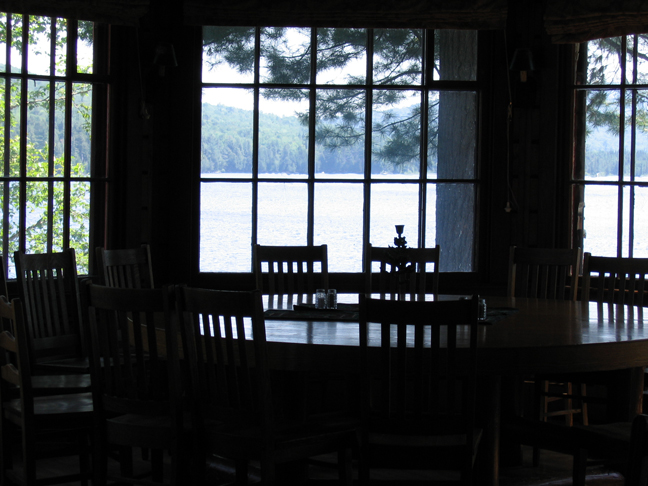- Sagamore Camp
Infobox_nrhp | name =Sagamore Lodge
nrhp_type =nhl

caption =A view ofLake Sagamore from the dining hall.
nearest_city=Raquette Lake, New York
lat_degrees = 43 | lat_minutes = 45 | lat_seconds = 55.65 | lat_direction = N
long_degrees = 74 | long_minutes = 37 | long_seconds = 38.25 | long_direction = W
area =
built =1897
architect=William West Durant
architecture= Other
designated=May 16 ,2000 cite web|url=http://tps.cr.nps.gov/nhl/detail.cfm?ResourceId=1021390518&ResourceType=Building
title=Sagamore Lodge|accessdate=2007-09-11|work=National Historic Landmark summary listing|publisher=National Park Service]
added =January 11 ,1976 cite web|url=http://www.nr.nps.gov/|title=National Register Information System|date=2007-01-23|work=National Register of Historic Places|publisher=National Park Service]
governing_body = Private
refnum=76001221Sagamore Camp is one of several historic
Great Camps located in theAdirondack Mountains of northern New York State, which were built for the super-rich of the AmericanGilded Age as remote and luxurious rustic summer retreats. It was constructed byWilliam West Durant on Sagamore Lake between 1895-1897. Durant was the son ofThomas C. Durant (1820-1885), a railroad tycoon and financial manipulator who briefly gained control of theUnion Pacific Railroad during the 1860s, and whose machinations resulted in the 1872 Crédit Mobilier scandal. By the 1870s Thomas Durant had become the largest private landowner in the Adirondacks, and he had delegated his son to develop portions of his holdings for future sale to the moneyed elite. Prior to Sagamore, William Durant had constructedCamp Pine Knot (purchased byCollis P. Huntington and now the Huntington Memorial Outdoor Education Center [http://www.cortland.edu/outdoor/raquette/huntington.html] ) andCamp Uncas (once owned byJ. P. Morgan ), both on nearbyRaquette Lake . All three camps are still in use today.In 1901 Durant was forced to sell Sagamore, reputedly because a lawsuit by his sister over his mismanagement of their mother's estate had pushed him to the edge of bankruptcy. [Kaiser, Henry K.: "Great Camps of the Adirondacks", p87-94. David R. Godine Publisher, 2003] It was purchased by
Alfred Gwynne Vanderbilt , who expanded and improved the property to include flush toilets, a sewer system and hot and cold running water. He later added a hydroelectric plant and an outdoor bowling alley with an ingenious system for retrieving the balls. Other amenities included a tennis court, a croquet lawn, a 100,000 gallon reservoir, and a working farm. Vanderbilt died in 1915, a victim of the Lusitania sinking, leaving Sagamore to his widowMargaret Emerson , an avid sportswoman who continued to occupy the camp for many years.Mrs. Emerson transferred the property to
Syracuse University , which operated a conference center here until theState of New York offered to buy it. Acquisition by the State as part of theForest Preserve would have required demolition of the historic buildings, because of the "Forever Wild" provision of theNew York State Constitution . To avert this, thePreservation League of New York arranged with the State to take title, transferring the property with deed restrictions to a not-for-profit institution that would provide suitable occupancy. Camp Sagamore has continued to function as a conference center.The camp is arranged in two complexes a half-mile apart, the Upper, or worker's complex, and the Lower, or guest complex. The guests would not have frequented the worker's complex, as the buildings here are much more utilitarian than those in the Guest complex, and without the embellishment of the buildings designed for entertaining. Sagamore served as a sylvan setting in which the richest families in America could relax, party, and get a feeling of returning to nature. All of this, however, was accomplished without leaving the comforts of civilization behind.
A portion of Sagamore was listed on the National Register of Historic Places in 1976. A boundary increase for additional area was included in a multiple property submission for listing in 1986.citation|title=PDFlink| [http://www.nr.nps.gov/multiples/64000555.pdf National Register of Historic Places Inventory-Nomination: Great Camps of the Adirondacks] |2.75 MiB |date=July, 1986 |first=Larry E. |last=Gobrecht |publisher=National Park Service] The camp was designated as a
National Historic Landmark on2000-05-16 . cite web|url=PDFlink| [http://pdfhost.focus.nps.gov/docs/NHLS/Text/76001221.pdf "Sagamore Camp", July 30, 1999, by Wesley Haynes] |2.61 MiB |title=National Historic Landmark Nomination|accessdate=2007-09-18|publisher=National Park Service] ,cite web|url=PDFlink| [http://pdfhost.focus.nps.gov/docs/NHLS/Photos/76001221.pdf Sagamore--Accompanying 8 photos, exterior, from 1999.] |1.71 MiB |title=National Register of Historic Landmark Nomination|accessdate=2007-09-18|publisher=National Park Service] The historic camp is now run by Sagamore Institute of the Adirondacks, Inc. [http://www.sagamore.org] and is open to the public by guided tour, as well as offering accommodations May through October.References
External links
* [http://www.sagamore.org Sagamore's official site]
* [http://www.cr.nps.gov/nhl/themes/Architecture/2camp.pdf Haynes, Wesley. Adirondack Great Camp Theme Study]*
*
*
*
Further reading
*cite book | last = Kirschenbaum | first = Howard | authorlink = | coauthors = | year = 2001 | title = Story of Sagamore | publisher = North Country Books | location = | id = ISBN 0-913393-02-9
*cite book | last = Kaiser | first = Harvey H. | authorlink = | coauthors = | year = 2003 | title = Great Camps of the Adirondacks | publisher = David R. Godine | location = | id = ISBN 1-56792-073-X
*cite book | last = Gilborn | first = Craig A. | authorlink = | coauthors = | year = 2000 | title = Adirondack Camps: Homes Away from Home, 1850-1950 | publisher = Syracuse University Press | location = | id = ISBN 0-8156-0626-5
*cite book | last = Gilborn | first = Craig | authorlink = | coauthors = | year = 1981 | title = Durant: Fortunes and Woodland Camps of a Family in the Adirondacks | publisher = North Country Books | location = | id = ISBN 0-932052-24-X
Video documentaries
*
*
Wikimedia Foundation. 2010.
